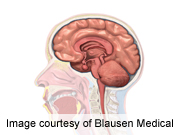- Navigating Your Midlife Crisis: Embracing New Possibilities
- City Raccoons Showing Signs of Domestication
- Mapping the Exposome: Science Broadens Focus to Environmental Disease Triggers
- One Week Less on Social Media Linked to Better Mental Health
- Your Brain Changes in Stages as You Age, Study Finds
- Some Suicide Victims Show No Typical Warning Signs, Study Finds
- ByHeart Formula Faces Lawsuits After Babies Sickened With Botulism
- Switch to Vegan Diet Could Cut Your Greenhouse Gas Emissions in Half
- Regular Bedtime Does Wonders for Blood Pressure
- Dining Alone Could Mean Worse Nutrition for Seniors
Brain Structure Might Help Predict Risky Behavior


Your brain structure could help predict how willing you are to take financial risks, a new study suggests.
Researchers at Yale University found those with greater volume in a part of the brain known as the parietal cortex may be more likely to engage in risky behavior than people with less volume in this area.
The study, funded by the U.S. National Institute on Aging, involved two groups of young adult men and women living in the Northeast. The researchers sought to determine how brain structure influences risk taking when economics or money is involved.
The first group of 28 people made decisions about lotteries of varying levels of risk. Their brains were analyzed using MRI technology. The findings, published Sept. 10 in the Journal of Neuroscience, were confirmed in a second group of 33 people.
“Based on our findings, we could, in principle, use millions of existing medical brain scans to assess risk attitudes in populations,” Ifat Levy, an assistant professor in comparative medicine and neurobiology at Yale School of Medicine, said in a university news release. “It could also help us explain differences in risk attitudes based in part on structural brain differences.”
The researchers noted, however, their findings don’t establish a cause-and-effect relationship. “We don’t know if structural changes lead to behavioral changes or vice versa,” Levy explained.
It’s known that the parietal cortex thins with age, the researchers pointed out. Previous studies have shown that people become less willing to take risks as they age. The study authors said that more, larger studies are needed to expand on their research.
“It could be that this thinning explains the behavioral changes; we are now testing that possibility,” said Levy.
More information
The U.S. National Institute of Neurological Disorders and Stroke provides more information on the workings of the human brain.
Source: HealthDay
Copyright © 2025 HealthDay. All rights reserved.










